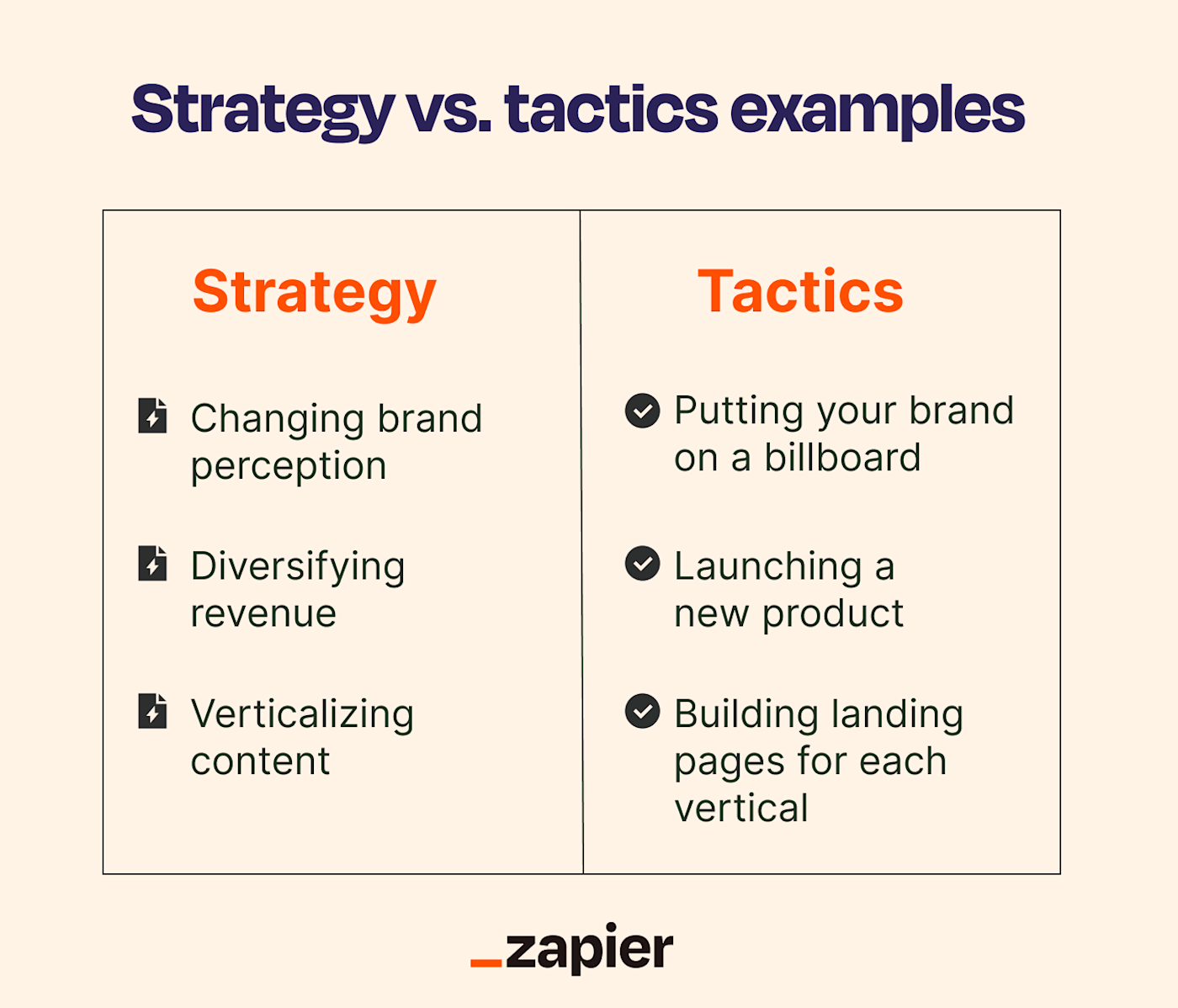Have you ever gone to the grocery store without a grocery list, then tried to make your meals for the week with a random assortment of products? The meals were inevitably less nutritious and less delicious. There were probably plenty of items you needed but didn't get, and other items you didn't need that went to waste.
Grocery shopping is a tactic. Meal planning—including that crucial grocery list—is the strategy. It's what bridges the gap between a random mishmash of produce and the actual ingredients you need for a satisfying meal.
If it's that crucial for your weekly grocery run, you can imagine how important the distinction between strategy and tactics is for a business.
Strategy vs. tactics: What's the difference?
Your strategy is what you want to do, whereas your tactics are how you actually do it. Strategy guides the actions you take by ensuring they lead to the outcome you want.
For example, imagine you're trying to bake a cake from a store-bought boxed mix. Your strategy might be to deceive your friends into thinking it's an old family recipe. Your tactics might be to add an extra egg and an intense arm workout as you vigorously whip the batter like it owes you money.
Having tactics without strategy is like trying to bake that cake without even glancing at the instructions on the back of the box. You might have the flour, sugar, and that enthusiasm to impress, but without a recipe, you're basically tossing ingredients into a bowl and crossing your fingers it doesn't emerge from the oven as a brick.
What is strategy?
A strategy is the overall plan for how to achieve a goal. It's the "big picture" thinking that goes into deciding what you want to accomplish. A good strategy is typically long-term in focus and should be flexible enough to adapt to changing circumstances.
For example, a business aiming to expand its global presence might develop a strategy that includes entering emerging markets, shaking hands with the right partners, and leveraging online platforms for wider reach. But it's not as simple as pasting dreams on a vision board and hoping they materialize. They'd also have to think about the real headaches, such as cultural differences or regulatory changes, and incorporate contingencies to address them effectively.
What goes into a good strategy?
Crafting a killer strategy is more than just saying, "We'll do better next year." It's a coherent mix of insightful analysis, clear objectives, and an actionable game plan. To cook up a winning strategy, consider the following:
Set goals: What's the endgame? Ensure your goal ticks the SMART criteria—specific, measurable, achievable, relevant, and time-bound.
Evaluate your current situation: Identify your assets and challenges through a SWOT analysis: what are your strengths and weaknesses, and what external opportunities and threats should you pay attention to?
Take stock of your resources: What people, money, time, and other resources do you have in your toolkit?
Identify risks: What could go wrong? And how can you sidestep those hurdles?
Use your resources strategically: How will you play your cards to hit that goal?
Once you've considered all of these factors, you can start to develop a strategy. A good strategy should be:
Clear and concise: It should be straightforward and easily relayed to others. Cut jargon where possible, and aim to make it digestible not just to C-suite executives. Strategies can vary in length from a one-page overview to a 50-page document, depending on the complexity of the goal and the level of detail required.
Practical: It should be grounded in reality, considering your available resources. Take stock of what resources you have vs. what you'll need to invest in, and weigh the ROI of those investments.
Flexible and adaptable: Be ready to roll with the punches because life loves throwing curveballs. Have alternative directions prepared in advance, so you aren't left scrambling the moment something doesn't go as planned.
Once you have the big picture sorted, it's time to get granular with how to tackle each step of your plan.
What are tactics?
Think of tactics as the boots-on-the-ground moves in the business battlefield. While a strategy sets the long-term vision, tactics zoom in on the nitty-gritty, dealing with day-to-day operations and short-term objectives. They encompass concrete steps like rolling out a marketing campaign or tweaking a production process. Due to their short-term focus, tactics can (and should) be frequently adjusted based on real-time feedback. They are the "how-to" steps to turn your overall plan into reality.
What goes into good tactics?
You can ace your tactical game regardless of your goals by considering these pointers:
Break down your goals into smaller tasks. Divide your big goals into bite-sized chunks. It's like that weird idiom about eating an elephant: one bite at a time.
Delegate tasks to others. This will free up your time so that you can focus on the most important aspects of your tactics. Passing the baton not only lightens your plate but also empowers others.
Stay on your toes. Set milestones and touchpoints with team members to ensure they're on track, using a project management tool to help everyone stay synced. If progress is delayed or otherwise thrown off track, recalibrate and keep rolling.
By following these tips, you can use tactics to your advantage and achieve your goals more effectively.
Strategy vs. tactics examples
In business, your strategy will always tie your tactics to your bottom line. For example:
Changing your brand perception is a strategy; putting your brand on a billboard is a tactic.
Diversifying revenue is a strategy; launching a new product is a tactic.
Verticalizing your content is a strategy; creating landing pages for each vertical is a tactic.

Ever been caught in the "strategy vs. tactics" debate in the Kohl's checkout line? Just me? Either way, I'll break it down with real-world examples to distinguish the broader goals (strategies) from the actionable steps (tactics) that bring them to fruition.
Customer service example
Strategy: Improve the customer support experience by focusing on three key areas: response time, agent expertise, and efficiency.
Tactics:
Implement a chatbot to handle frequently asked questions, freeing up agents for more complex queries.
Provide monthly training to agents on efficient problem-solving and communication techniques.
Utilize advanced ticketing systems to prioritize and assign queries based on urgency and complexity.
Gamify the support process—fastest response time wins "Employee of the Hour."
QA and production example
Strategy: Enhance product quality through defect detection and continuous improvement.
Tactics:
Invest in state-of-the-art quality inspection equipment to detect defects early in the production process.
Conduct monthly feedback sessions with the production team to discuss challenges and potential improvements.
Collaborate with suppliers to ensure the quality of raw materials.
Schedule bi-monthly "How to get it just right" workshops with free pizza.
Human resources example
Strategy: Cultivate a motivated, engaged, and high-performing workforce by focusing on employee satisfaction and retention.
Tactics:
Implement a comprehensive employee feedback system to understand and address concerns.
Offer competitive benefits, including wellness programs and flexible working hours.
Organize quarterly team-building and professional development workshops to foster a positive work environment.
Sales example
Strategy: Boost eCommerce sales through web user experience and engagement through retargeting and value-driven promotions
Tactics:
Optimize the website for mobile devices to enhance the shopping experience for mobile users.
Introduce bundle deals or combo offers to encourage higher purchase values.
Use retargeting ads to re-engage visitors who abandoned their shopping carts.
Host a "Flashback Friday" sale where prices are rolled back to what they were in the '90s. Unless you sell computer hard drives.
Marketing example
Strategy: Expand brand awareness in new markets by building genuine connections with the local community and aligning the brand with their values and interests.
Tactics:
Collaborate with local influencers or celebrities for product endorsements in the new market.
Organize community events or sponsor local initiatives to gain brand visibility.
Launch culturally relevant marketing campaigns that resonate with the target audience in the new region.
Host "Guess who we are" game nights at a local establishment.
Why tactics without strategy ends in disaster (and why so many businesses do it anyway)
Tactics are more visible because they're driven by action and lead to a tangible result. That's what makes it so tempting to dive right into tactical execution—it's the fastest way to get something to show for your work.
But doing things that way can be detrimental to your resources. While strategizing may feel a little fuzzy and adds time to the process, having a solid strategy is the only way to make your tactics worthwhile. Tactics without strategy result in a lot of effort that might not help you meet your goals and a lot of data that doesn't actually tell you anything.
It's a hard urge to fight, though, which is why strategy-barren tactics can be found everywhere. They can appear as leveraging a new tool just because it's exciting or launching a new product or feature that doesn't address a customer pain point (Colgate once attempted to market and sell a frozen lasagna).
When it comes to tactics vs. strategy, it's all about thinking before you act.
How strategy and tactics go hand in hand
You need both strategies and tactics to achieve your business goals, but there's an order of operations.
1. Start with strategy
Remember, your strategy is what you're trying to accomplish, not what you're going to do. To create your strategy, you need to first nail down the following:
Business goal: Why are you doing this in the first place, and how will it contribute to your business's bottom line?
Key performance indicators (KPIs): What metrics will you track, and how will you quantify success?
Target audience: Who do you want to reach with this initiative?
2. Determine your tactics
Your strategy can now guide the creation of your tactics: the things you actually do to execute your strategy and reach your goal. When creating your tactics, think about:
Distribution: Where will you execute?
Assets: What and how many are you creating?
Timing: When will you execute?
Think of this step as the bridge between your strategy and your execution. Even though you now have enough information to start thinking about tactics, you're still in the planning phase, which allows you to make these tactical decisions strategically.
It's important to note that these three components will look slightly different depending on the nature of your initiative. It really just breaks down to the where, what, and when (which you can answer now that you've established the why, how, and who in your strategy).
3. Benchmark your current status and make a plan for measurement
To ensure your execution aligns with your strategy and is actually driving business value, make sure you have both the tools and methodology to track your KPIs before your project kicks off.
You'll want to put some forethought into both how (which tools and who owns it) and when measurement happens, as well as the results you need to see to consider your initiative a success. Most importantly, you'll want to benchmark where you currently stand, so you can effectively attribute your success to the hard work you've put in.
4. Execute and track results
This is the part you've been waiting for—the doing. Your reward for putting in the work to create a strategy and plan is that you know the work you do to execute will be meaningful. Track your progress based on your plans from the previous stage—and don't forget to celebrate.
Common mistakes brands make when executing on a strategy
When doing the strategy vs. tactic dance, there are a few common pitfalls that can keep you from reaching your goals once you're in the execution stage. I learned some of these the hard way, so keep your eye out for them.
Shiny object syndrome
Shiny object syndrome takes hold when a new and exciting tactic is available—but offers no real business value. Kiera Wiatrak, brand strategy and marketing consultant and founder of Dogeared Digital, said that when Facebook first offered a video view objective in their ads platform, she ran a hefty video campaign and ended up with a lot of views—and nothing else: "People (me) get excited by the cool factor and fail to see that the fun new tactic doesn't align with their strategy," she said. The good news: if you're consistently using your strategy as your guidepost, you can avoid this.
Getting too caught up in the details
While it's important to make a plan, it's just as important to assume things won't go as planned. In my many years in marketing, I've never once seen a project go off without a hitch. That's ok—it keeps things fresh. What you want to avoid is losing the forest for the trees and letting one area of your work eat up disproportionate time and resources. This is easily avoidable by revisiting your strategy often and reprioritizing as needed.
Refusing to pivot when something's not working
You have to be willing to let go. If something isn't providing a justifiable return on investment, you need to be ready and willing to change tactics—or even scrap part or all of your project. The sunk cost fallacy is tough here. Just remember everything you do for your business provides new learnings that will get you closer the next time.
Let automation help with the tactics
Starting with a strategy prevents you from allocating time and resources to initiatives that don't drive business objectives, allowing for more efficient work and a stronger ROI. Once you set your strategy and your plan for action, be sure to revisit it often in the execution stage. Tactics without strategy will get you nowhere, fast.
As you execute on your tactics, automation is your friend. Let the robots take care of the tedious work—from scheduling to project management to analytics—so you can focus on making sure everything ties back to your strategy.
Related reading:
An exhaustive guide to customer acquisition strategy (with 13 examples)
19 marketing channels: How to choose the right ones—and leverage them effectively
How to research a digital marketing plan for your small business (and why it matters)
Communication plan templates for business (and how to create your own)
This article was originally published in October 2018 by Kiera Wiatrak. The most recent update was in November 2023.






